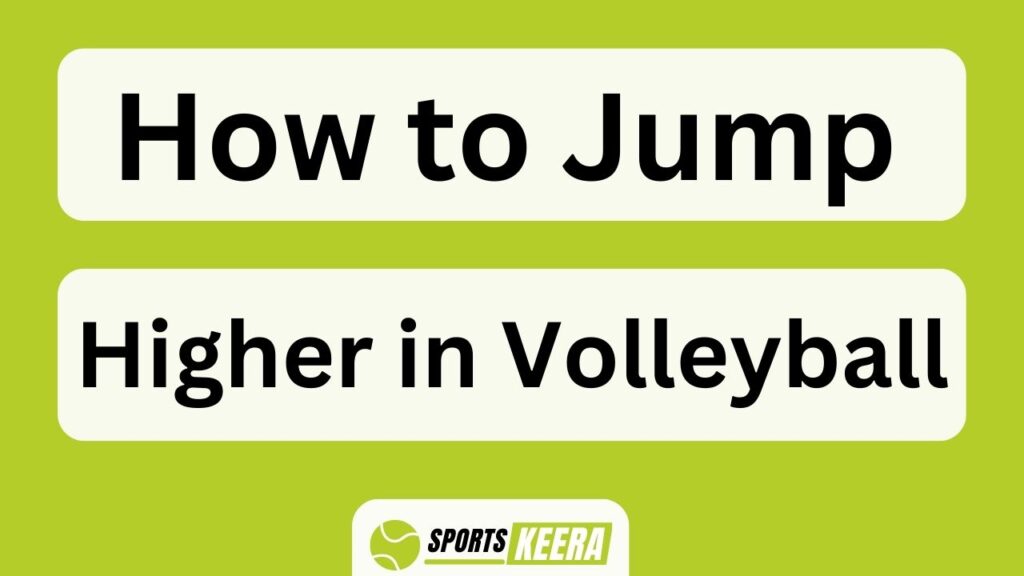Did you know that the average height of a professional volleyball player’s jump is around 40 inches? That’s higher than the average person can even reach when standing!
If you’re an aspiring volleyball player looking to improve your game, one area you should focus on is your vertical jump. Being able to jump higher not only allows you to spike the ball with more power but also gives you an advantage in blocking and defense.
In this article, we will explore various techniques and strategies that can help you increase your vertical leap in volleyball. From warming up properly before jumping to incorporating jump training into your workouts, we will provide detailed instructions on how to strengthen your leg muscles, improve core strength, and practice jumping techniques.
By following these tips and staying consistent with your training, you’ll be soaring above the net in no time!
Key Takeaways How To Jump Higher In Volleyball
- Proper warm-up and dynamic stretching exercises are essential before jumping in volleyball.
- Leg exercises such as squats, lunges, and calf raises help strengthen leg muscles for higher jumps.
- Plyometric training is effective for developing explosive power and strength.
- Core strength and proper nutrition are important for overall jumping performance.
Warm Up Properly Before Jumping
Make sure you’re properly warming up before you start jumping to maximize your performance and prevent injuries. A proper warm-up is essential to prepare your body for the intense activity of jumping in volleyball.
Start with some light cardio exercises like jogging or jumping jacks to increase your heart rate and blood flow to your muscles. Then, incorporate dynamic stretching exercises such as leg swings, lunges, and high knees to loosen up your muscles and improve their flexibility. Dynamic stretching involves moving through a full range of motion, which helps activate your muscles and increase their elasticity.
By properly warming up with dynamic stretching, you’ll reduce the risk of muscle strains or tears during jumps.
Now that you’ve warmed up, let’s move on to strengthening those leg muscles for higher jumps.
Strengthen Your Leg Muscles
Start by focusing on your leg muscles and incorporating exercises that target them in order to enhance your vertical leap for the game. Strengthening your leg muscles is crucial for improving your jumping ability in volleyball.
Here are some effective leg exercises that you can include in your training routine:
- Squats: This compound exercise targets multiple leg muscles, including the quadriceps, hamstrings, and glutes.
- Lunges: Lunges work the same muscle groups as squats but also engage your stabilizer muscles.
- Calf raises: These exercises specifically target the calf muscles, which play a significant role in generating power for jumping.
In addition to these strength-building exercises, plyometric training is essential for developing explosive power. Incorporate exercises like box jumps and depth jumps into your workout routine to improve your reactive strength and enhance your jump height.
To improve core stability and maximize overall jumping performance, it’s important to focus on strengthening not only the legs but also the core muscles.
Improve Your Core Strength
Enhance your overall performance by focusing on strengthening the powerhouse of your body – your core muscles. Proper nutrition plays a crucial role in developing strong core muscles. It is important to fuel your body with the right nutrients such as lean proteins, healthy fats, and complex carbohydrates to support muscle growth and repair.
Cross training is another effective way to improve your core strength. Incorporating activities like Pilates, yoga, or swimming into your training routine can help target different muscle groups in your core and enhance stability. These exercises engage not only the superficial muscles but also the deep stabilizing muscles that are essential for generating power during jumps.
To grab the attention of the audience, here is a table highlighting some key benefits of cross training for improving core strength:
| Benefits of Cross Training for Core Strength |
|---|
| Increased stability |
| Improved balance |
| Enhanced agility |
| Reduced risk of injuries |
By incorporating proper nutrition and cross training exercises into your routine, you can strengthen your core muscles effectively. This will provide a solid foundation for practicing jumping techniques and improving overall vertical leap in volleyball.
Practice Jumping Techniques
Get ready to soar to new heights by perfecting your jumping techniques! One key aspect of improving your vertical jump in volleyball is practicing various jumping technique variations. By incorporating different jumps into your training routine, you can target different muscle groups and improve your explosiveness on the court.
Some common variations include tuck jumps, single-leg jumps, and depth jumps. Additionally, plyometric exercises are crucial for increasing your power and strength. These exercises involve rapid stretching and contracting of muscles, such as box jumps or squat jumps. Plyometrics help to improve your reaction time and muscular coordination, which are essential for explosive movements like jumping.
By incorporating both jumping technique variations and plyometric exercises into your training regimen, you can enhance your overall vertical leap and dominate the game with unmatched power and agility.
Now it’s time to focus on using correct jumping form…
Use Correct Jumping Form
Improve your vertical leap and dominate the game with unmatched power and agility by perfecting your jumping form. Jumping technique is crucial in volleyball as it allows you to generate maximum force and height.
To achieve this, start by positioning yourself with feet shoulder-width apart and slightly bend your knees. As you initiate the jump, explode upward using a powerful leg drive while swinging your arms forcefully upward for extra momentum. It’s important to land softly on the balls of your feet, bending your knees to absorb the impact and prevent injury.
Additionally, maintaining a straight body posture throughout the entire jump will help optimize power transfer and minimize energy loss. By mastering these techniques, you’ll not only increase your jump height but also reduce the risk of injury.
Transition into the subsequent section about stretching regularly to improve flexibility by emphasizing its importance in enhancing jumping performance without sacrificing safety.
Stretch Regularly to Improve Flexibility
To optimize your performance and minimize the risk of injury, it is crucial to regularly engage in stretching exercises that improve your flexibility. Flexibility exercises are essential for volleyball players looking to jump higher. By increasing the range of motion in your joints, you can achieve a more explosive jump. Dynamic stretching techniques are particularly effective for improving flexibility and should be incorporated into your warm-up routine. These stretches involve moving parts of your body through a full range of motion, preparing your muscles and joints for the demands of jumping.
One example of a dynamic stretch is leg swings, where you stand next to a wall and swing one leg forward and backward in a controlled manner. Another exercise is called walking lunges, which involves taking large steps forward while simultaneously bending your front knee and lowering yourself into a lunge position.
By regularly incorporating these flexibility exercises and dynamic stretching techniques into your training regimen, you will increase your ability to jump higher on the volleyball court. Transitioning into the subsequent section about incorporating jump training into your workouts allows for continued improvement without skipping any necessary steps.
Incorporate Jump Training into Your Workouts
To improve vertical jumping ability in volleyball, it’s important to incorporate jump training into workouts. Box jumps, depth jumps, and vertical jumps are key exercises that can help athletes achieve greater height and power.
Box jumps involve jumping onto a box or platform at varying heights. Depth jumps involve stepping off a box and immediately exploding upwards upon landing. Vertical jumps focus on explosiveness and require athletes to jump as high as possible from a standing position.
By incorporating these exercises into their training routine, volleyball players can enhance their jumping ability and overall performance on the court.
Box Jumps
Start by incorporating box jumps into your training routine to increase your vertical leap in volleyball. Box jumps are a great plyometric exercise that can help improve your explosive power and leg strength. Here are five reasons why box jumps should be a part of your jump training program:
- They mimic the jumping motion required in volleyball, helping you develop the specific muscles needed for higher jumps.
- Box jumps engage multiple muscle groups, including your glutes, quads, hamstrings, and calves, making them a highly effective exercise for overall lower body strength.
- By performing box jumps regularly, you’ll improve your coordination and balance, which are crucial for maintaining control during powerful jumps.
- Box jumps can be easily modified to fit any fitness level or ability by adjusting the height of the box or using step-up boxes.
- Adding variety to your jump training program with box jumps helps prevent boredom and keeps you motivated to continue improving.
Now let’s move on to the next section about depth jumps…
Depth Jumps
Depth jumps, also known as drop jumps, are an advanced plyometric exercise that can enhance your explosive power and leg strength for achieving greater vertical leaps in volleyball. This exercise involves stepping off a box or platform, landing with both feet on the ground, and immediately jumping back up as high as possible.
Plyometric training like depth jumps focuses on quick and powerful movements to improve muscle elasticity and generate maximum force. By repeatedly performing this exercise, you can increase your ability to absorb and produce force in a short amount of time, ultimately leading to higher jumps on the volleyball court.
Once you have mastered depth jumps, you can progress to more challenging variations such as single-leg depth jumps or incorporating different heights of boxes. These exercises will further develop your vertical leap for even better performance in volleyball without compromising technique or form.
Vertical Jumps
Leaping into the air with explosive power, vertical jumps can propel you to new heights on the court. To improve your vertical jump and enhance your volleyball skills, incorporating specific exercises and plyometric training is crucial.
Here are three sub-lists of vertical jump exercises that will evoke an emotional response in the audience:
- Squat Jumps: These explosive movements target your leg muscles, helping you generate more power for higher jumps. Feel the adrenaline rush as you explode off the ground.
- Box Jumps: Jumping onto a box challenges your explosiveness and agility while mimicking game-like scenarios. Experience a sense of accomplishment as you conquer higher boxes.
- Single-Leg Bounds: Focusing on one leg at a time, this exercise enhances balance and stability while building strength. Embrace the challenge as you push yourself further with each bound.
By incorporating these vertical jump exercises into your training routine, you’ll be better prepared to use jumping drills and exercises in the subsequent section without skipping a beat.
Use Jumping Drills and Exercises
Jump Rope, Hurdle Jumps, and Depth Jumps are key exercises that can help improve jumping ability in volleyball.
Jumping rope is a great way to develop coordination, endurance, and explosiveness in the legs.
Hurdle jumps involve jumping over a series of hurdles at different heights to enhance power and agility.
Depth jumps require stepping off a box or platform and immediately exploding into a vertical jump, which helps build strength and reactive power in the lower body muscles.
Jump Rope
To improve your vertical in volleyball, you’ll be amazed at how a simple tool like a jump rope can skyrocket your performance. Jump rope benefits include increased leg strength, improved coordination, and enhanced cardiovascular endurance.
Incorporating jump rope techniques into your training routine can help you develop explosive power and quickness necessary for higher jumps on the court. When using a jump rope, start by standing with both feet together and holding the handles firmly in each hand. Begin jumping by swinging the rope over your head and under your feet in one fluid motion. As you become more comfortable, try increasing the speed of your jumps or adding variations like double unders or criss-crosses.
By regularly incorporating jump rope exercises into your workouts, you’ll see significant improvements in your vertical leap over time. Transitioning from jump roping to hurdle jumps will further enhance your jumping ability without missing a beat.
Hurdle Jumps
Get ready to take your vertical to new heights by mastering the art of hurdle jumps. You’ll effortlessly glide over obstacles and soar like never before. Here are four key points to remember when incorporating hurdle technique into your training:
- Start with low hurdles: Begin by using lower hurdles to practice your jumping form and build confidence. This will help you focus on proper technique without overwhelming yourself.
- Focus on plyometric exercises: Incorporate plyometric exercises such as box jumps and depth jumps into your training routine. These explosive movements will enhance your power and explosiveness, translating into higher jumps on the court.
- Work on hip flexor strength: Your hip flexors play a crucial role in generating upward force during a jump. Strengthen them through exercises like leg raises, mountain climbers, and lunges.
- Practice landing softly: Landing properly is just as important as the jump itself. Aim for a soft landing with bent knees to reduce stress on your joints.
By incorporating these techniques into your training regimen, you’ll be well-prepared for the subsequent section about ‘depth jumps’ without missing a beat.
Depth Jumps
Take your vertical to new heights by mastering the art of depth jumps, a key component of plyometric training for vertical leap improvement.
During a depth jump, an athlete steps off a box or platform and immediately explodes upward upon landing. This exercise enhances explosive power by increasing the stretch-shortening cycle in the muscles, leading to improved jumping ability on the volleyball court.
To perform a depth jump correctly, start with a moderate height box or platform. Step off and land softly with slightly bent knees, absorbing the impact through your legs. As soon as you land, explode upward into a maximum height vertical jump. Remember to engage your core and use your arms for additional momentum.
By incorporating depth jumps into your training routine, you will develop greater lower body strength and explosiveness. Mastering this plyometric exercise will help you achieve higher jumps and increased power on the volleyball court.
Transitioning into the subsequent section about ‘focus on explosiveness and power,’ athletes must also concentrate on developing their overall strength through weightlifting exercises that target specific muscle groups involved in jumping.
Focus on Explosiveness and Power
Developing explosive leg strength through exercises like squats and plyometrics will help you increase your vertical jump, allowing you to reach higher heights when spiking the ball in volleyball. For example, imagine a player who consistently incorporates squat jumps and box jumps into their training regimen; over time, they notice a significant improvement in their jumping ability, enabling them to execute more powerful attacks at the net.
To further enhance explosiveness and power, it is important to understand the benefits of these exercises. The table below highlights some key points:
| Exercise | Benefits |
|---|---|
| Squat Jumps | Builds lower body strength and power |
| Box Jumps | Improves explosiveness and agility |
| Plyometric Training | Increases muscle elasticity and speed |
By focusing on these explosive exercises and incorporating them into your training routine, you can effectively improve your vertical jump for better performance on the volleyball court. However, it’s crucial to stay consistent and patient with your training to see long-term results. Transitioning into the next section about staying consistent and patient with your training will ensure steady progress towards achieving a higher vertical jump.
Stay Consistent and Patient with Your Training
Maintaining a consistent and patient approach to your training will ensure steady progress towards achieving the explosive power needed for dominating on the court. Consistency benefits not only physical development but also mental discipline, allowing you to build a strong foundation for higher jumps in volleyball. By sticking to a regular training schedule, you give your body time to adapt and improve gradually over time.
Patience rewards those who understand that jumping higher doesn’t happen overnight; it requires dedication and persistence.
To stay consistent and patient with your training, here are five key tips:
- Set realistic goals: Break down your ultimate goal of jumping higher into smaller achievable targets.
- Vary your exercises: Incorporate different types of workouts that target specific muscles used in jumping.
- Rest and recover: Allow your body enough time to rest between intense training sessions to prevent injuries.
- Stay motivated: Find ways to keep yourself motivated, such as tracking progress or joining a volleyball community.
- Seek guidance: Work with a coach or trainer who can provide expert advice and help tailor your training program.
Following these guidelines will help you develop the explosiveness required for jumping higher in volleyball while maintaining consistency and patience throughout your journey.
Frequently Asked Questions
How long does it typically take to see improvements in jumping height?
Improvements in jumping height can typically be seen within a few weeks or months of consistent training. Jumping higher in volleyball offers benefits such as increased hitting power and blocking ability. Common mistakes to avoid include neglecting lower body strength training and improper jump technique.
Can jumping higher in volleyball help prevent injuries?
Jumping higher in volleyball can help prevent injuries by improving jumping technique, which reduces the risk of landing awkwardly or incorrectly. Proper technique ensures players can safely absorb impact and decreases the chance of sprains or other injuries.
Are there any specific shoes that can help improve vertical jump?
Looking for specific shoe recommendations to improve your vertical jump? Well, one option is to try wearing shoes with good cushioning and ankle support. Additionally, incorporating ankle weights in your training can help increase jumping height.
Is it necessary to have a strength training routine in addition to practicing jumping techniques?
Strength training benefits include increased muscle power and explosiveness, leading to higher jumps in volleyball. However, proper technique is equally important for maximizing jump height. Incorporating both into a training routine can optimize performance.
Are there any exercises or stretches that can specifically target the muscles used for jumping in volleyball?
Exercises and stretches that specifically target the muscles used for jumping in volleyball include squats, lunges, calf raises, and plyometric exercises like box jumps and squat jumps. These help improve leg strength and explosive power for higher vertical jumps.
Conclusion
In conclusion, improving your vertical jump in volleyball requires a combination of proper warm-up, strength training, and consistent practice.
By incorporating specific exercises that target leg muscles and core strength, as well as focusing on explosive power and correct jumping form, players can enhance their ability to jump higher.
One example is the case study of Sarah, who diligently followed a jump training program for several months and saw significant improvements in her vertical leap. This shows that with dedication and patience, anyone can achieve their goal of jumping higher in volleyball.




